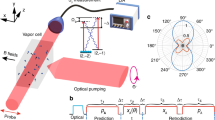Abstract
In quantum mechanics, the state of an individual particle (or system) is unobservable, i.e., it cannot be determined experimentally, even in principle. However, the notion of “measuring a state” is meaningful if it refers to anensemble of similarly prepared particles, i.e., the question may be addressed: Is it possible to determine experimentally the state operator (density matrix) into which a given preparation procedure puts particles. After reviewing the previous work on this problem, we give simple procedures, in the line of Lamb's operational interpretation of quantum mechanics, for measuring a translational state operator (whether pure or mixed), via its Wigner function. These procedures closely parallel methods that might be used in classical mechanics to determine a true phase space probability distribution; thus, the Wigner function simulates such a distribution not only formally, but operationally also.
There is no way to determine what the wave function (or state vector) of a system is—if arbitrarily given, there is no way to “measure” its wave function. Clearly, such a measurement would have to result in afunction of several variables, not in a relatively small set ofnumbers .... In order to verify the [quantum] theory in its generality, at least a succession of two measurements are needed. There is in general no way to determine the original state of the system, but having produced a definite state by a first measurement, the probabilities of the outcomes of a second measurement are then given by the theory.
E. P. Wigner(1)
Similar content being viewed by others
References
E. P. Wigner, inQuantum Optics, Experimental Gravitation and Measurement Theory, P. Meystre and M. O. Scully, eds. (Plenum, New York, 1983), pp. 44 and 47.
E. C. Kemble,The Fundamental Principles of Quantum Mechanics (Dover, New York, 1937), p. 71.
W. Gale, E. Guth, and G. T. Trammel,Phys. Rev. 165, 1434 (1968).
G. T. Trammel,Phys. Tod. 22, 9 (1969).
B. d'Espagnat,Conceptual Foundations of Quantum Mechanics, 2nd edn. (W. A. Benjamin, Reading, Massachusetts, 1976), Sect. 7.1.
W. Pauli,General Principles of Quantum Mechanics (Springer, Berlin, 1980), p. 17.
W. E. Lamb, Jr.,Phys. Tod. 22, 23 (1969).
A. Royer,Phys. Rev. Lett. 55, 2745 (1985).
E. P. Wigner,Phys. Rev. 40, 749 (1932).
S. R. de Groot and L. G. Suttorp,Foundations of Electrodynamics (North-Holland, Amsterdam, 1972), Appendix to Chap. VI.
S. R. de Groot,La Transformation de Weyl et la Fonction de Wigner (Les Presses de l'Université de Montréal, Montréal, 1974).
V. I. Tatarskii,Sov. Phys. Usp. 26, 311 (1983).
R. F. O'Connell,Found. Phys. 13, 83 (1983).
N. L. Balazs and B. K. Jennings,Phys. Rep. 104, 347 (1984).
M. Hillery, R. F. O'Connell, M. O. Scully, and E. P. Wigner,Phys. Rep. 106, 121 (1984).
U. Fano, inLectures on the Many-Body Problem, Vol. 2, E. R. Caianiello, ed. (Academic, New York, 1964).
I. Prigogine, C. George, C. Henin, and L. Rosenfeld,Chem. Scripta 4, 5 (1973).
P. A. M. Dirac,The Principles of Quantum Mechanics, 4th end. (Oxford University Press, Oxford, 1958).
J. von Neumann,Mathematical Foundations of Quantum Mechanics (Princeton University Press, Princeton, 1955).
J. A. Wheeler and W. H. Zurek, eds.,Quantum Theory and Measurement (Princeton University Press, Princeton, 1983).
U. Fano,Rev. Mod. Phys. 29, 74 (1957).
A. Einstein, B. Podolsky, and N. Rosen,Phys. Rev. 47, 777 (1935).
C. D. Cantrell and M. O. Scully,Phys. Rep. 43, 499 (1978).
M. O. Scully, R. Shea, and J. D. McCullen,Phys. Rep. 43, 486 (1978).
R. H. Dicke,Am. J. Phys. 49, 925 (1981).
D. Bohm,Phys. Rev. 85, 166 (1952).
B. R. Mollow,Phys. Rev. 162, 1256 (1967).
A. Grossmann,Commun. Math. Phys. 48, 191 (1976).
A. Royer,Phys. Rev. A 15, 449 (1977).
R. G. Glauber,Phys. Rev. 131, 2766 (1963).
K. Wodkiewicz,Phys. Rev. Lett. 52, 1064 (1984).
Author information
Authors and Affiliations
Rights and permissions
About this article
Cite this article
Royer, A. Measurement of quantum states and the Wigner function. Found Phys 19, 3–32 (1989). https://doi.org/10.1007/BF00737764
Received:
Revised:
Issue Date:
DOI: https://doi.org/10.1007/BF00737764



